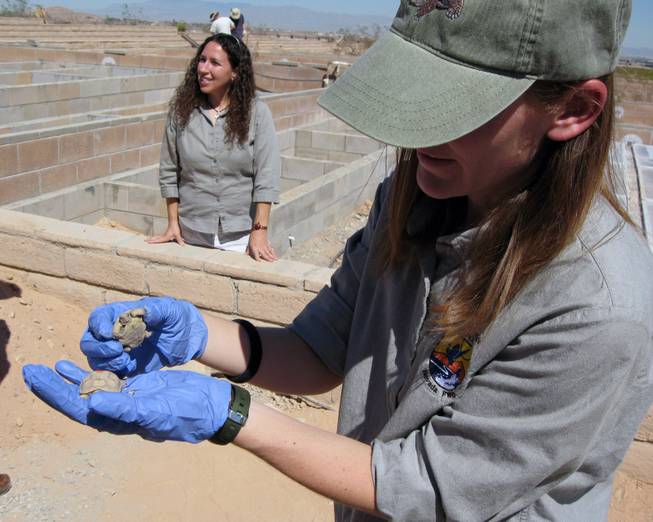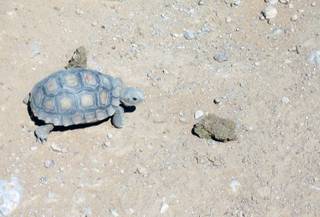
Kim Field, a biologist with the U.S. Fish and Wildlife Service, on Thursday shows off two desert tortoises that were born a few days ago at the Desert Tortoise Conservation Center.
Friday, Sept. 25, 2009 | 1:55 a.m.
Hotline
The Clark County Desert Tortoise Pickup Service provides free pick up of desert tortoises to developers who do voluntary surveys of their property prior to disturbance and to individuals who find a tortoise wandering near urban development. To schedule a pick up, call the Desert Tortoise Hotline at 702-593-9027. More information is available at mojavemax.com.
Beyond the Sun
Desert Tortoise Conservation Center
The San Diego Zoo has moved into the Las Vegas Valley to study and help repopulate the desert with an endangered species of tortoises.
The center held a media day Thursday to highlight some of the changes at the Desert Tortoise Conservation Center, which it took over in March.
“The overall vision for the Desert Tortoise Conservation Center is to play a critical role in conserving and restoring wild desert tortoise populations and their native desert habitat,” said Allison Alberts, chief conservation officer for the San Diego Zoo’s Institute for Conservation Research.
The zoo plans to use the center for researching, breeding and raising the tortoises, training new researchers and educating the public, Alberts said.
It has hired five full-time employees to work at the center and has five seasonal workers helping inventory the animals. Additionally, staff members from the zoo in San Diego occasionally come to the center for training, research and to help in medical procedures, she said.
“We are going to play, I hope, a really significant role in recovering the species because one of the things that we can do is rehabilitate these tortoises and put them back into the wild,” said Paula Kahn, who manages the center for the zoo.
The zoo has plenty of experience working with endangered species, breeding them in captivity and then releasing them to the wild.
Allison cited the zoo’s work with the California condor, which at one time was down to just 22 living birds. Now there are more than 350 of the birds and half of them live in the wild.
That's just one of the more than 100 conservation programs run by the zoo in 35 countries, Alberts said.
Las Vegas’ close proximity to San Diego was an extra incentive for the zoo to get involved in the tortoise program here, she said.
“We do work globally, but we also feel a strong obligation and interest in work on local conservation issues in the Southwest,” Alberts said.
And it was the zoo’s work with other endangered species in the area that led to the U.S. Fish and Wildlife Service approaching the zoo about a new partnership, she said.
“It was kind of a natural fit for San Diego and Fish and Wildlife to work on this together,” Alberts said.
Roy Averill-Murray, the U.S. Fish and Wildlife Service’s desert tortoise recovery coordinator, said the zoo’s experience with conservation is going to be a key to success in the program.
“Desert tortoise recovery in general is a big task and we need a lot of partners, a lot of expertise,” he said. “With a facility like this where we’re receiving a lot of tortoises, having their expertise just from a captive husbandry standpoint is huge.”
The center was established in 1990. In 2007, the U.S. Fish and Wildlife Service took over the facility, which is on more than 11,000 acres managed by the Bureau of Land Management. The center is in rural Clark County, south of Blue Diamond Road and Rainbow Boulevard.
“We’re really optimistic to get some new projects going and really capitalize on the collective expertise,” Averill-Murray said. “(This will) really maximize the potential that the partnership has and that the facility has. It really is a cause for optimism to do some good things for desert tortoise recovery.”
Desert tortoises were listed as an endangered species in 1989, Averill-Murray said, but many people already had them as pets and were allowed to keep them.
In addition, a limited number of tortoises -- usually animals that can’t be released back to the wild -- can be adopted from the center, Alberts said.
It is illegal to take a tortoise from the wild or to release a captured tortoise.
The center takes in tortoises turned in by people who no longer want them as pets -- they can live for more than 100 years -- or when they are found injured in the wild.
People can call the Clark County Desert Tortoise Hotline, 702-593-9027, to arrange a pick-up of the animal.
More than 1,000 tortoises come to the center each year, Kahn said, and 3,000 or 4,000 are already living there.
Since it opened, the center has released 8,000 tortoises to the wild.
The zoo hopes to dramatically increase that number and study the animals further to make sure the ones they release survive, Alberts said.
The zoo also hopes to use the center to help people learn more about the animals and to teach proper care for those who have them.
“The center has a great potential to contribute to public education, both about what’s going on in the wild and about the issue of pet tortoises,” Alberts said.
Plans are in the works for school field trips and other small groups to visit the center, she said.
The center isn’t open to the public because of the need to quarantine many of the animals, but staff members do sometimes take the animals with them to speak at schools and other places, Alberts said.
“We do go to the community, but we’d love to bring the community here on a limited basis,” she said.
And in the distant future, the center could turn into something even larger, perhaps even something of a tourist destination for people interested in the animals.
“If you really think big about the future vision of the Desert Tortoise Conservation Center it could become a real hub for education about the Mojave ecosystem in general,” Alberts said. “That’s something we would definitely love to look for in the long term future of the place.”


Join the Discussion:
Check this out for a full explanation of our conversion to the LiveFyre commenting system and instructions on how to sign up for an account.
Full comments policy